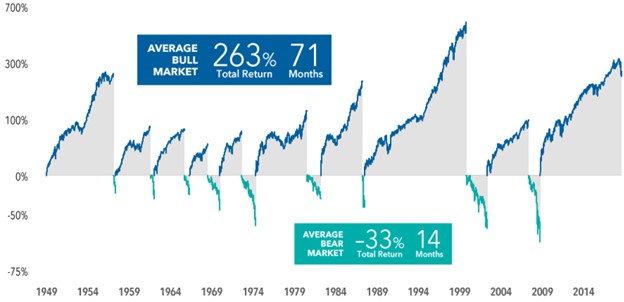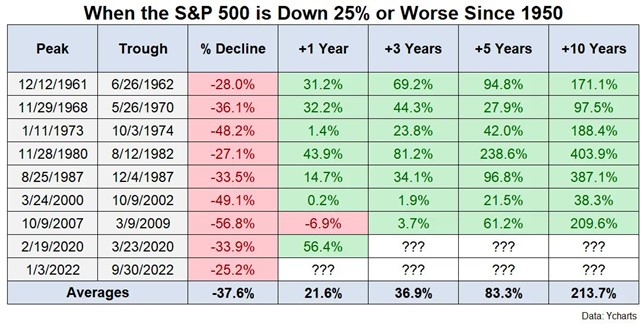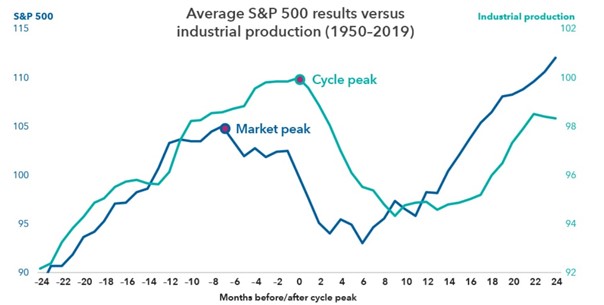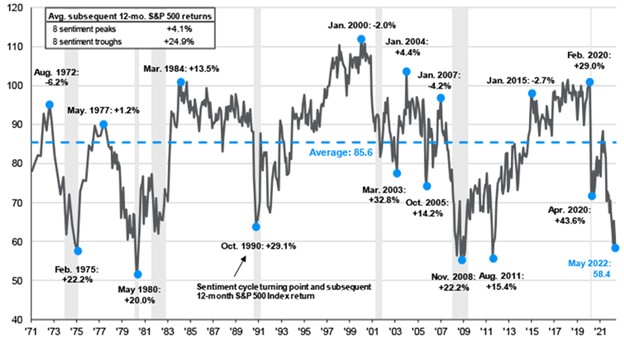Enduring wisdom on how to approach bear markets
October 2022
There is nothing enjoyable about market corrections and/or recessions. They create fear, anxiety and uncertainty. Perspective can go a long way to successfully navigating these periods, uncomfortable and difficult as they may be. Outlined below is some enduring wisdom we can share having invested through bear markets and as students of history.
1) Corrections, bear markets and recessions are normal things
Volatility is an unfortunate but necessary phase in market cycles. Opportunity and volatility are irrevocably linked because without volatility, there would be little to no opportunity in investing. A similar comment can be made regarding recessions. They can both help reset expectations that become unreasonable at times and remove highly speculative (and often unproductive) activities that do not contribute to growing the economy. Reminding ourselves that these periods are normal and even healthy helps build perspective that such events can create as much opportunity as they do concern.
Frequency of Market Events Since 1950

Source: Capital Group; Environment is the S&P 500; Average Frequency assumes 50% recovery of lost value; Average Length measures market high to market low. 1) National Bureau of Economic Research as of May 2022.
2) Recessions and corrections are points in time, while wealth-creating bull markets happen over time
Markets have been incredible creators of wealth over time. Below we demonstrate not just the frequency of bull versus bear markets, but the disproportionate outcomes skewed towards the positive. As shown, the total return of bull markets over time has been nearly 8x the drawdown of bear markets and have persisted over 5x as long.
It is also worth noting that these returns happened over a period in which the U.S. was engaged in four wars (Korean, Vietnam, Persian Gulf and the War on Terror), a Presidential assassination, Civil Rights riots, stagflation, higher interest rates, lower interest rates, multiple recessions, etc. The resilience of wealth creation builds context for the period in which we live now and how it may feel volatile or unprecedented. It is not unprecedented, and this too shall pass.
Bull Markets Happen Over Time, Bear Markets Are Points In Time

Source: Capital Group, RIMES, Standard & Poor’s. As of December 31, 2018. Bear markets are peak-to-trough price declines of 20% or more in the S&P 500. Bull markets are all other periods. Returns are shown on a logarithmic scale.
3) Market Timing– Getting it right is hard and getting it wrong is costly
Market timing requires three things to get it right: correctly timing the sell, doing it in a large enough size that it matters and correctly timing the buy on the way back in. Timing “buys and sells” is difficult because it involves having the fact pattern right and the appropriate market reaction to execute it consistently. As an analogue to why this is so hard, let’s pretend it is 2019. You are told that next year the U.S. economy will go into a recession, unemployment will be high, large sections of the country will be shut down and over 300 thousand people in the U.S. will die from a pandemic not seen in modern times. Not only is that set of facts nearly unknowable ahead of time, but even fewer would look at that information and predict the market would end the year up 19 percent.
Additionally, the vast majority of the best days in the market have happened during market pullbacks. At the times it is most tempting to make a move, it may also be the most dangerous time to do it. Half of the S&P 500 Index’s strongest days in the last 20 years occurred during a bear market. Another 34% of the market’s best days took place in the first two months of a bull market—before it was clear a bull market had begun. (1)
Furthermore, the chart below shows the last 9 drawdowns of 25% or greater in the S&P 500. Note that leading up to the current period, the average recovery in the following 12 months was +20%. While we don’t know when things will turn around, it can be helpful to see how other bear markets of similar magnitude have fared.

Source: Ben Carlson – Getting Long-Term Bullish. Returns are calculated from the first day of the month after reaching the trough.
4) Recession obsession: don’t focus too much on the wrong thing
In periods of market volatility, investors’ gazes often turn to judging whether a recession will occur. Recession-seeking may be a red herring when it comes to investing. Markets attempt to look forward to predict the future while economic data is inherently backward looking. On average since 1950, markets have peaked seven months prior to an economic peak and bottomed three months before the economy began growing again. While a recession may help provide context around the potential depth or length of a pullback, it may not be the most helpful focus point for market outcomes.

Source: Capital Group. 1950 – 2019
5) Investing on emotion may feel right at the time, but is less likely to be a profitable approach
As humans we are hardwired to act, especially when we feel uncomfortable. After all, both fight and flight are responses. Thus, we find it hard to “do nothing.” One of our best proxies for feelings in the market is consumer sentiment. When sentiment is low, investors are pessimistic and the innate feeling to act is high. If sentiment is high, investors are optimistic about the future. However, if we look back at how profitable feelings are, we quickly learn that following our gut may not be the most beneficial approach. As shown in the chart below, investing when things feel the worst on average has been 6x more successful than the opposite.
Returns of the S&P 500 Based on Investor Sentiment

Source: JPMorgan. January 1970 – May 2022
In times of plenty, investors often lose sight of basic building blocks of well-allocated portfolios. Fear of missing out when markets run up is a powerful motivator. We believe the following are elements of a more optimal approach for long-term success:
Stay Diversified –
- Diversification is an admittance of not knowing what the future holds. It also helps avoid acting in absolutes like “value will never come back” or “fixed income is dead.”
- Diversification can reduce the role of chance in your investment outcomes. Said another way, it increases the reliability of your outcome.
- The discipline of diversification often leads to a more robust approach that can help weather the inevitable storm markets create.
Stick to the Plan –
- Strategies work over-time, not all the time.
- Have faith in the process and remember the plan was built knowing recessions and bear markets would happen.
- Recognize the skillset that has likely contributed to your success in business (controlling for results) can be counterproductive when navigating market pullbacks.
Long-Term is Where the Real Money is Made –
- Achieving your long-term goals is the primary objective of investing.
- Compounding over the long-term may be the 8th wonder of the world.
- Short-term expectations often lead to “flavor of the day” investing, which rarely stands the test of time.
- Stay long-term and let the markets work for you, rather than you working against them.
1 – Source: Ned Davis Research, 12/21. Time period referenced is 12/16/01–12/15/21.
Information has been obtained from a variety of sources believed to be reliable though not independently verified. Any forecasts represent future expectations; actual returns, volatilities and correlations will differ from forecasts. This report does not represent a specific investment recommendation. Please consult with your advisor, attorney and accountant, as appropriate, regarding specific advice. Past performance does not indicate future performance and there is a possibility of a loss.
Comparisons to any indices referenced herein are for illustrative purposes only and are not meant to imply that actual returns or volatility will be similar to the indices. Indices cannot be invested in directly. Unmanaged index returns assume reinvestment of any and all distributions and do not reflect our fees or expenses.
– The S&P 500 is a capitalization-weighted index designed to measure performance of the broad domestic economy through changes in the aggregate market value of 500 stocks representing all major U.S. industries.
